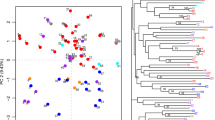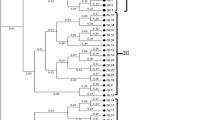Abstract
Blackberry genetic relationships (Rubus subgenus Rubus Watson) have not been thoroughly studied. The University of Arkansas maintains one of the largest blackberry-breeding programs in the world and thus, in-depth knowledge of the cultivars released from the program and others instrumental in their lineages can aid in breeding endeavors. Pedigrees of 32 cultivars were traced to their founding clones. Genetic contribution (GC), maximum potential similarity (MPS), inbreeding coefficient, and coefficients of relationship (CR) were calculated for all genotypes. Nineteen founding clones contributed to the 32 cultivars, ranging from <1% to ∼19%. The top three founding clones for mean GC conferred nearly 50% to the 32 cultivars in this study, suggesting a somewhat narrow genetic base. Calculations for MPS ranged from complete similarity (1.00) to 0.00. Individual inbreeding coefficients ranged from 0.00 to 0.25. The coefficient of relationship was used as a method of determining genetic relatedness and ranged from 0.00 to 0.74. University of Arkansas cultivars had the highest MPS and CR in the study. This may be attributed to more generations of hybridization than the other cultivars. The MPS provided some comparable results to those of RFLP and RAPD molecular studies, but CR did not. The rather narrow genetic base of eastern North American blackberry cultivars does not create an imminent, significant concern for loss of diversity. However, more diverse germplasm should be infused for continuation of heterogeneity.
Similar content being viewed by others
References
Alice, L.A. & C.S. Campbell, 1999. Phylogeny of Rubus (Rosaceae) based on nuclear ribosomal DNA internal transcribed spacer region sequences. Amer J Bot 86: 81–97.
Barr, A.J., 1983. The inbreed procedure. In: S.P. Joyner (Ed.), SUGI Supplemental Library User’s Guide, 1983 edn., pp. 121–130. SAS Inst., Cary, NC.
Clark, J.R., 1999. The blackberry breeding program at the University of Arkansas: Thirty-plus years of progress and developments for the future. Acta Hort 505: 73–77.
Dale, A., P.P. Moore, R.J. McNicol, T.M. Sjulin & L.A. Burmistrov, 1993. Genetic diversity of red raspberry varieties throughout the world. J Amer Soc Hort Sci 118: 119–129.
Darrow, G.M., 1937. Blackberry and raspberry improvement. In: Better Plants and Animals 2, pp. 496–533. USDA Yearbook of Agriculture.
Darrow, G.M., 1967. The cultivated raspberry and blackberry in North America—Breeding and improvement. Amer Hort Mag 46: 202–218.
Degani, C., L.J. Rowland, J.A. Saunders, S.C. Hokanson, E.L. Ogden, A. Golan-Goldhirsh & G.J. Galleta, 2001. A comparison of genetic relationship measures in strawberry (Fragaria x ananassa Duch.) based on AFLPs, RAPDs, and pedigree data. Euphytica 117: 1–12.
Falconer, D.S. & T.F.C. Mackay, 1996. Introduction to quantitative genetics. 4th edn., Longman, Essex, England.
Graham, J. & R.J. McNicol, 1995. An examination of the ability of RAPD markers to determine the relationships within and between Rubus species. Theor Appl Genet 90: 1128-1132.
Graham, J., R.J. McNicol, K. Greig & W.T.G. van de Ven, 1994. Identification of red raspberry cultivars and an assessment of their relatedness using fingerprints produced by random primers. J Hort Sci 69: 123–130.
Graham, J., G.R. Squire, B. Marshall & R.E. Harrison, 1997. Spatially dependent genetic diversity within and between colonies of wild raspberry Rubus idaeus detected using RAPD markers. Mol Ecol 6: 1001–1008.
Hall, H.K., 1990. Blackberry breeding. In: J. Janick (ed.), Plant Breeding Reviews, Vol. 8, pp. 249–312. Timber Press, Portland, Ore.
Hancock, J.F., Jr. & J.H. Siefker, 1982. Levels of inbreeding in highbush blueberry cultivars. HortScience 17: 363–366.
Hedrick, U.P., 1925. The small fruits of New York. J.B. Lyon Co., Albany, N.Y.
Jennings, D.L., 1967. Balanced lethals and polymorphism in Rubus idaeus. Heredity 22: 465–479.
Jennings, D.L., 1972. Aberrant segregation of a gene in the raspberry and its association with effects on seed development. Heredity 29: 83–90.
Lewers, K.S., E.T. Stafne, J.R. Clark, C. Weber & J. Graham, 2004. Simple sequence repeat (SSR) markers for raspberry and blackberry. HortScience 39(4): 785 (abstr.).
M.L.A., Lima, A.A.F., Garcia, K.M., Oliveira, S. Matsuoka, H. Arizono, C.L. de Souza Jr. & A.P. de Souza, 2002. Analysis of genetic similarity detected by AFLP and coefficient of parentage among genotypes of sugar cane (Saccharum spp.). Theor Appl Genet 104: 30–38.
Lopez-Medina, J., J.N. Moore & R.W., McNew, 2000. A proposed model for inheritance of primocane fruiting in tetraploid erect blackberry. J Amer Soc Hort Sci 125: 217-221.
Mantel, N.A., 1967. The detection of disease clustering and a generalized regression approach. Cancer Res 27: 209–220.
Moore, J.N., 1984. Blackberry breeding. HortScience 19: 183–185.
Nybom, H. & H.K. Hall, 1991. Minisatellite DNA ‘fingerprints’ can distinguish Rubus cultivars and estimate their degree of relatedness. Euphytica 53: 107–114.
Nybom, H., B.A. Schaal & S.H. Rogstad, 1989. DNA “fingerprints“ can distinguish cultivars of blackberries and raspberries. Acta Hort 262: 305–310.
Ourecky, D.K., 1975. Brambles. In: J. Janick & J.N. Moore (Eds.), Advances in Fruit Breeding, pp. 98–129. Purdue University Press, West Lafayette, Indiana.
Pamfil, D., R.H. Zimmerman, S.K. Naess & H.J. Swartz, 2000. Investigation of Rubus breeding anomalies and taxonomy using RAPD analysis. Small Fruits Rev 1: 43–56.
Rohlf, F.J., 2000. NTSYS-pc numerical taxonomy and multivariate analysis system, version 2.1. Exeter Publishing, Ltd., Setauket, N.Y.
Sjulin, T.M. & A. Dale, 1987. Genetic diversity of North American strawberry cultivars. J Amer Soc Hort Sci 112: 375–385.
Stafne, E.T. & J.R. Clark, 2004. PediTrack—A simple pedigree program for lineage tracking. HortScience 39: 649 (abstr.).
Stafne, E.T., J.R. Clark, M.C. Pelto & J.T. Lindstrom, 2003. Discrimination of Rubus cultivars using RAPD markers and pedigree analysis. Acta Hort 626: 119–124.
Stafne, E.T., A.L. Szalanski & J.R. Clark, 2004. Nuclear ribosomal ITS region sequences for differentiation of Rubus genotypes. J. Ark. Acad. Sci. 57: 176–180.
Trople, D.D. & P.P. Moore, 1999. Taxonomic relationships in Rubus based on RAPD analysis. Acta Hort 505: 373–378.
Wright, S., 1922. Coefficients of inbreeding and relationship. Amer Nat 56: 330–338.
Author information
Authors and Affiliations
Corresponding author
Rights and permissions
About this article
Cite this article
Stafne, E., Clark, J. Genetic relatedness among eastern North American blackberry cultivars based on pedigree analysis. Euphytica 139, 95–104 (2004). https://doi.org/10.1007/s10681-004-2436-4
Received:
Accepted:
Issue Date:
DOI: https://doi.org/10.1007/s10681-004-2436-4




